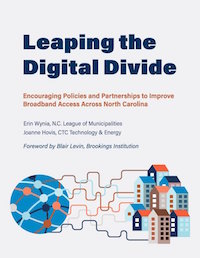
Fast, affordable Internet access for all.
The North Carolina League of Municipalities (NCLM) released a report in March with several recommendations designed to help the state boost connectivity for residents, businesses, and organizations. NCLM Legislative Counsel Erin Wynia and CTC Technology and Energy President Joanne Hovis authored the report that offers policy changes to encourage smart partnerships.
Download the report, Leaping the Digital Divide: Encouraging Policies and Partnership to Improve Broadband Access Across North Carolina.
The report dedicates time describing different public-private partnership models and the elements that make them distinct. In recent years, the term has been used to describe a broad spectrum of arrangements. We've highlighted partnerships in places like Westminster, Maryland, and Urbana-Champaign, Illinois, where both partners invest and share in risk and reward.
The North Carolina Situation
Wynia and Hovis spend time on the gap of coverage in rural areas vs coverage in urban areas. They compare data from the North Carolina Broadband Infrastructure Office and the FCC’s form 477. The authors explain why FCC data is so flawed and provide examples of real people who’s lives are impacted due to access to broadband, or lack of it, in their community.
Fiber is the best option for future-proof, fast, affordable, reliable connectivity. Wynia and Hovis compare fiber to other technologies and explain we can’t let hype cloud our long-term thinking. We were happy to supply our map of private ISP fiber availability in North Carolina so readers can see where it’s currently deployed in the state.
 The report looks at the state’s existing law that limits local authority regarding municipal broadband infrastructure. As the authors point out, state law does not expressly address local communities’ authority as it relates to public-private partnerships. They recommend the law be clarified to allow municipalities the unquestionable authority to raise and spend funds on broadband infrastructure. They also recommend communities be expressly allowed to lease the infrastructure to private sector partners.
The report looks at the state’s existing law that limits local authority regarding municipal broadband infrastructure. As the authors point out, state law does not expressly address local communities’ authority as it relates to public-private partnerships. They recommend the law be clarified to allow municipalities the unquestionable authority to raise and spend funds on broadband infrastructure. They also recommend communities be expressly allowed to lease the infrastructure to private sector partners.
Wynia and Hovis also recommend that state law be amended to ease current restrictions on cooperatives that wish to offer broadband service. As we addressed in our report, North Carolina Connectivity: The Good, The Bad, and The Ugly, North Carolina electric cooperatives have their hands tied by financial limitations from state law. These barriers need to be resolved. Rural cooperatives are quickly emerging as a strong force for fiber optic deployment in areas where traditional corporate ISPs won’t serve.
The authors also recommend that the state establish a grant fund, similar to the Minnesota Border-to-Border Broadband Program, that would allow entities to compete for resources to help deploy infrastructure projects.
From the report conclusion:
Two decades into the digital revolution, it has become clear that private-sector solutions alone are not going to close this gap, and that large private-sector providers and their investments will continue to primarily focus on densely-populated areas. At the same time, local governments – as experienced providers and builders of infrastructure – are uniquely positioned to help close the digital divide. They cannot accomplish that task though without help at the state policy level.
At a March 21st news conference to share recommendations from the report, NCLM President Michael Lazzara said:
“Broadband is crucial 21st century infrastructure, no different than water and sewer, electricity and roads. It is critical that everyone have access to it, and that businesses in towns and cities of all sizes have access to the internet speeds that they require to conduct commerce across the country and around the globe.”
Download the report and read the recomendations for North Carolina.
Video from the press March 21st press conference:
Image of the Wilson, North Carolina Train Station by DanTD (Own work) [CC BY-SA 3.0], via Wikimedia Commons.

